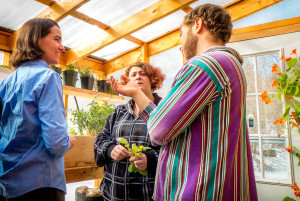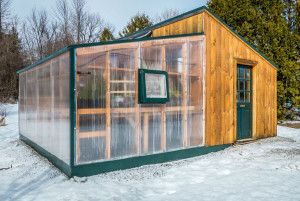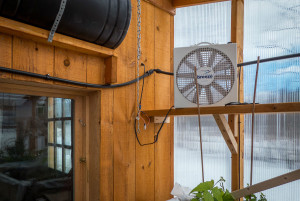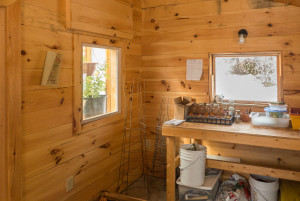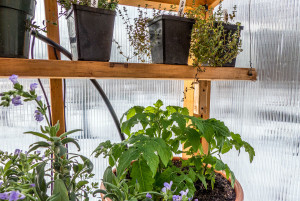Growing healthy futures
A visit to the greenhouse at the Parent Child Center
It was the second week of March. And with a foot of snow on the ground and the outside temperature hovering around 15 degrees, spring seemed a long way off indeed.
So it was pure delight to step into a warm sunny greenhouse filled with growing things: trays of green mesclun ready to harvest; a prolific red nasturtium casually draped around a window and an enormous pink New Guinea impatiens.
Dick and I were at Middlebury’s Parent Child Center that serves young parents throughout Addison County, providing them with an accredited high school education and other services. (Each county in Vermont has a similar program.) And, looking at the tidy row of colorful car seats beside the front door, I was reminded that caring for their young children is also very much a part of the PCC mission.
Inside the center’s greenhouse we chatted with Deirdre Kelly and Joe Pearl, PCC director of education and science teacher respectively, and Rhiannon Howard, an enthusiastic program participant.
Two UVM Extension Master Gardeners, Shari Johnson and Anne Collins from Cornwall, were also on hand to show us around.
Since the temperature inside the greenhouse was nearly 80 degrees and most of the space allocated to growing crops, the seven of us were quite a snug group!
As a gardener I was fascinated to see how this family-sized greenhouse was designed and built to facilitate food production. And, as a caring citizen, it was wonderful to learn about local programs that support our young people. Here are some of the impressions I took home from our ninety minute visit.
Healthy food on a limited budget
Deirdre explained that the greenhouse is part of the larger gardening program at the center. It all began a few years back when she and a group of participants were discussing the importance of a healthy diet that includes plenty of fresh vegetables. The students all said that their biggest challenge was the ability to buy healthy food on a limited budget. And, since many of them were apartment dwellers, it was difficult to have their own gardens.
One outgrowth of this discussion was to apply to the Vermont-based Canaday Family Charitable Trust for sufficient funds to build and equip a new energy efficient greenhouse at the center. The PCC was delighted to receive the funding, and Jonathan Hescock of Vermont Victory Greenhouses in Cornwall was contracted to build the structure.
Building the new greenhouse became a family affair
During that summer Jonathan and his colleagues at Vermont Victory Greenhouses constructed a 10’ x 15’ wood-framed greenhouse with an attached potting shed. Students also built three outdoor raised beds, resulting in a true year-round growing space.
Even now, three years on, people are still talking about how Jonathan went ‘above and beyond’ as he encouraged all the young parents at the center—both moms and dads— to work alongside him and his electrician friend. This created a wonderful opportunity for everyone to learn about real building activities such as cutting and joining lumber and assembling benches.
A greenhouse designed for efficiency and convenience.
During our visit Joe described some of the energy-efficient features of the greenhouse:
To maximize the collection of passive solar energy, the long wall of the greenhouse faces due south.
The walls are double-layer polycarbonate that, in addition to its superior insulating qualities, also diffuses the light for the plants.
Two large black water barrels act as passive heat storage elements. Situated inside, high up on the north wall (in otherwise unusable space), they absorb excess daytime heat that is then returned to the greenhouse at night. A small electric heater provides supplemental nighttime heating.
I had long known that, with a traditional freestanding greenhouse, the translucent north wall is virtually useless. It contributes very little added light for the plants or for solar heating, but at night it results in considerable heat loss.
So I thought the Victory Greenhouse solution at the PCC was both elegant and functional: they had replaced the typical translucent wall on the north side with a roomy insulated potting shed!
The greenhouse is also designed for convenience. In addition to having electricity and running water, all the benches are equipped with drip irrigation nozzles that keep the plants evenly moist. And, to prevent overheating on sunny days an electric fan—operated by a solar panel on the roof—circulates the inside air, and windows in the roof and side walls open automatically to provide cross ventilation.
Fresh food for young families
This is the third winter of greenhouse growing at the center. Currently organic mesclun is the main food crop (mostly using seeds donated by High Mowing Organic Seeds of Wolcott, Vermont). This is grown in large trays filled with local Moo-Doo potting soil from Middlebury’s Vermont Natural Ag Products.
Participants use the ‘cut and come again’ method of harvesting. The seed is broadcast fairly thickly over the soil, so that the seedlings soon fill the tray. At this point the growing plants are cut down to soil level, and allowed to regrow several more times.
As testament to the success of this method, every fortnight students deliver 5 lb. of mesclun to the PCC kitchen for everyone, parents and little children alike, to enjoy with their lunches.
This winter they have also delivered a variety of fresh herbs, some radishes and tomatoes, and even a green pepper—also much to the delight of the cook. As she commented recently: ‘My food budget doesn’t run to culinary herbs’!
I also saw a number of seedlings that, come spring, are destined for the raised beds outside. Cherry tomatoes are always popular, most especially with the little kids who love to eat them in a single mouthful!
As Rhiannon said, she really wants her 2-year-old daughter to learn to love healthy food—even when all her friends are devouring sugary drinks and unhealthy snacks.
All the young children at the center enjoy visiting the greenhouse where they are encouraged to explore the smells and tastes of fresh vegetables, and to dig in the soil and plant their own seeds. A large tray of soil set on the floor equipped with various gardening tools and gloves–just the right size for three-year old hands.
To maximize the harvest in a small space, students are also experimenting with the French Intensive Method of growing. In this technique a mixture of seeds are sown together in rows. The salad greens grow fastest and are harvested first. The radishes mature next. And, by the time spring arrives, the young broccoli and kale plants will be large enough to plant outside.
I also enquired about any crop failures. After all, as any gardener will tell you, there will always be something that does not work according to plan. Everyone told us how aphids completely infested the spinach. So, rather than risk spreading aphids to all the other crops, they decided to stop growing spinach inside.
Learning science
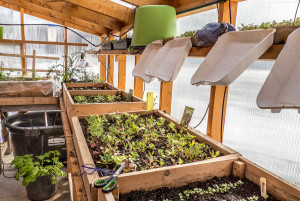
Large growing trays of mesclun. Above: containers of lettuce in the controlled experiment to determine the effect of potting soil composition on growth rate.
The greenhouse also plays an interesting role in the PCC science curriculum.
Rhiannon showed us a controlled experiment underway to determine how different potting soil mixes affect the rate of seedling growth. Four trays of mesclun with differing proportions of compost and peat moss were growing on the top shelf of the south wall. Once the mesclun is harvestable participants will evaluate which formula produced the best results.
Then Joe described the new aquaponics system. Very briefly: aquaponics is an ancient method of intensive agriculture that combines the principles of aquaculture—raising fish or other aquatic animals in tanks—and hydroponics—cultivating plants in water. At the PCC the goal is to investigate the use of aquaponics in a compact greenhouse setting.
First Joe, with the help of several participants and a Master Gardener/carpenter, built two large waist-height planting trays that they partially filled with different types of nonporous granular growing media—gravel of different sizes and small clay balls. Then they planted bean and pea seedlings, already started in standard Jiffy pellets, directly in the growing media.
Beneath the growing trays a pair of open black plastic tanks filled with water are home for the fish. Periodically a small pump floods the plant trays with some fish water, where the nitrogen-rich fish excretions gradually break down to fertilize the plants.
Currently one tray is flooded three times an hour, the other eight times an hour, but these times can be modified. The long-range goal is to pinpoint which growing medium and which flooding schedule optimizes the plant growth.
Master Gardeners are program mentors
And finally, I want to make a quick mention of the dedicated group of UVM Extension Master Gardeners who work behind the scenes to support the entire PCC gardening program. In addition to soliciting supplies and grants for the program, Master Gardeners are on hand both summer and winter, working with parents and little kids alike, and advising them about best gardening practices. In this way the Master Gardeners pass on their knowledge and love of growing things to a new generation of gardeners.

